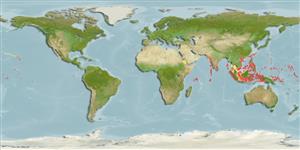>
Gobiiformes (Gobies) >
Gobiidae (Gobies) > Gobiinae
Etymology: Trimma: Greek, trimma, -atos = something crushed (Ref. 45335).
Eponymy: Dr Leighton R Taylor Jr (d: 1940) is a marine biologist who was Curator of Fishes (and later Director) at Waikiki Aquarium, Hawaii (1975–1986). [...] (Ref. 128868), visit book page.
Environment: milieu / climate zone / depth range / distribution range
Écologie
marin récifal; profondeur 20 - 50 m (Ref. 54980). Tropical; 28°N - 8°S
Indo-Pacific: Maldives to Hawaiian and Society Islands; Japan to Australia (Queensland and Northwest Shelf); throughout East Indian region.
Taille / Poids / Âge
Maturity: Lm ? range ? - ? cm
Max length : 3.5 cm SL mâle / non sexé; (Ref. 48637)
Description synthétique
Clés d'identification | Morphologie | Morphométrie
Épines dorsales (Total) : 7; Rayons mous dorsaux (Total) : 10 - 11; Épines anales: 1; Rayons mous anaux: 9 - 10. Males have longer dorsal spines and yellow spotting on the fins (Ref. 1602); characterized further by semi-translucent upper part of body, pinkish orange below; head and median fins with yellow orange spots; elongate and filamentous second dorsal spine; fifth pelvic ray branched, 75-85% length of fourth ray; longitudinal scale series 23-24; predorsal scales absent; cheek and opercle without scales; depth of body 4.0-4.2 in SL (Ref. 90102).
Benthopelagic (Ref. 58302). Occur in caves of drop-offs at depths of about 25 to at least 50 m (Ref. 48637, 58302). Form loose schools near the roofs or sides of caves and disappears into holes or crevices when approached. Often seen with other species of Trimma and feeds on harpacticoid copepods (Ref. 48637).
Life cycle and mating behavior
Maturité | Reproduction | Frai | Œufs | Fécondité | Larves
Myers, R.F., 1991. Micronesian reef fishes. Second Ed. Coral Graphics, Barrigada, Guam. 298 p. (Ref. 1602)
Statut dans la liste rouge de l'IUCN (Ref. 130435: Version 2024-2)
Menace pour l'homme
Harmless
Utilisations par l'homme
Pêcheries: sans intérêt
Outils
Articles particuliers
Télécharger en XML
Sources Internet
Estimates based on models
Preferred temperature (Ref.
123201): 24.6 - 28.5, mean 27.9 °C (based on 85 cells).
Phylogenetic diversity index (Ref.
82804): PD
50 = 0.5000 [Uniqueness, from 0.5 = low to 2.0 = high].
Bayesian length-weight: a=0.01023 (0.00477 - 0.02194), b=3.01 (2.83 - 3.19), in cm total length, based on LWR estimates for this (Sub)family-body shape (Ref.
93245).
Niveau trophique (Ref.
69278): 3.0 ±0.00 se; based on food items.
Résilience (Ref.
120179): Haut, temps minimum de doublement de population inférieur à 15 mois (Preliminary K or Fecundity.).
Fishing Vulnerability (Ref.
59153): Low vulnerability (10 of 100).
Nutrients (Ref.
124155): Calcium = 263 [125, 647] mg/100g; Iron = 1.31 [0.62, 2.55] mg/100g; Protein = 18.1 [16.1, 19.9] %; Omega3 = 0.176 [0.070, 0.380] g/100g; Selenium = 27.9 [11.9, 62.9] μg/100g; VitaminA = 138 [36, 510] μg/100g; Zinc = 3.26 [1.98, 5.05] mg/100g (wet weight);
